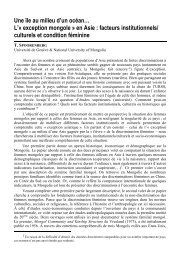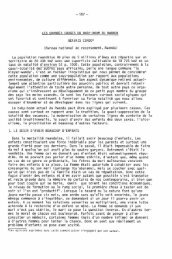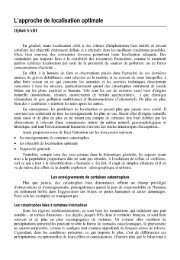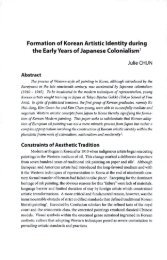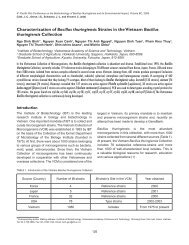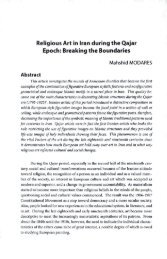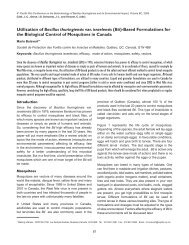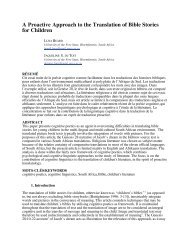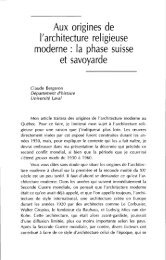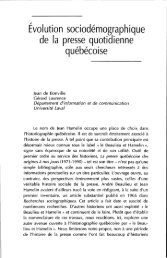PBL as a New Pedagogical Approach for Translator Education
PBL as a New Pedagogical Approach for Translator Education
PBL as a New Pedagogical Approach for Translator Education
You also want an ePaper? Increase the reach of your titles
YUMPU automatically turns print PDFs into web optimized ePapers that Google loves.
<strong>PBL</strong> <strong>as</strong> a <strong>New</strong> <strong>Pedagogical</strong> <strong>Approach</strong> <strong>for</strong> <strong>Translator</strong><br />
<strong>Education</strong><br />
RÉSUMÉ<br />
IZUMI INOUE<br />
Macquarie University, Sydney, Australia<br />
iinoue@ozemail.com.au<br />
Actuellement, la <strong>for</strong>mation traditionnelle des traducteurs est dominée par ce que Kiraly (2000)<br />
appelle une « approche transmissioniste ». Celle-ci est d’un intérêt limité lorsque les novices<br />
doivent appliquer ce qu’ils ont appris aux situations réelles rencontrées dans leur vie<br />
professionnelle. Il est donc désormais nécessaire de chercher une nouvelle approche qui nous<br />
permette d’aider les novices à développer leurs compétences propres.<br />
L’apprentissage par problèmes (APP) vise à promouvoir chez les novices l’autonomie et<br />
l’autoréflexion requises dans la pratique professionnelle face à des problèmes et à des situations<br />
difficiles. Si l’APP est de nos jours employé couramment dans ce cadre, aucune tentative notable<br />
n’a encore été faite pour introduire cette approche dans le domaine de la <strong>for</strong>mation des traducteurs.<br />
Cet article comporte trois volets principaux. Tout d’abord, nous discuterons des problèmes<br />
posés par un enseignement de la traduction centré sur l’enseignant. Puis nous présenterons les<br />
avantages de l’APP pour la <strong>for</strong>mation des traducteurs, dans une perspective tant théorique que<br />
pratique. Enfin, nous examinerons la faisabilité de l’APP en tant que modèle efficace pour la<br />
<strong>for</strong>mation des traducteurs, à partir d’études de c<strong>as</strong> empiriques.<br />
ABSTRACT<br />
It appears that current mainstream translator education is dominated by what Kiraly (2000) calls a
“transmissionist approach’. This approach is of limited benefit when the novices must apply<br />
what they have learnt to real situations that they will encounter <strong>as</strong> professionals. Thus, it can be<br />
said that we are at the point where we need to seek a new approach in which we can help novices to<br />
develop their own competence.<br />
Problem-B<strong>as</strong>ed Learning (<strong>PBL</strong>) is aimed at promoting novices’ autonomy and self-reflective<br />
actions which are required in a professional practice when they face problems and challenging<br />
situations. While <strong>PBL</strong> is now commonly employed in such are<strong>as</strong>, there h<strong>as</strong> <strong>as</strong> yet been no<br />
significant movement to introduce this approach in the area of translator education.<br />
This paper consists of three major components. First of all, the problems of<br />
educator-centred teaching in translation will be discussed. This will be followed by an outline of<br />
the benefits of <strong>PBL</strong> <strong>for</strong> translator education, from both theoretical and practical perspectives. The<br />
fe<strong>as</strong>ibility of <strong>PBL</strong> <strong>as</strong> an effective model <strong>for</strong> translator education will be then considered b<strong>as</strong>ed on<br />
empirical c<strong>as</strong>e studies.<br />
MOTS-CLÉS/KEYWORDS<br />
translator education, problem-b<strong>as</strong>ed learning, pedagogical approach, competence<br />
1. Introduction<br />
Various topics in the area of translation study, including equivalence, processes of translation and<br />
the use of genre-b<strong>as</strong>ed approaches, have been discussed in the existing literature but there seems to<br />
have been insufficient focus on the question of how translator education can best facilitate the<br />
evolution from a novice translator to an expert translator. As Kiraly (2000) points out, the<br />
“transmissionist approach” appears currently to be the mainstream pedagogical approach in the<br />
domain of translator education. In this <strong>for</strong>m of learning, a teacher (who is usually an expert
translator) provides a mere “answer” which the teacher then expects the novices to internalise <strong>as</strong><br />
knowledge, or learners <strong>as</strong>k questions and also expect categorical answers from the teacher. Thus,<br />
it can be said that the teacher in this approach acts <strong>as</strong> an instructor. While this method could be<br />
beneficial to both the teacher and learners from a cl<strong>as</strong>s management perspective where there are<br />
large numbers of learners, this way of learning could leave the learners with some problems. The<br />
first problem is that the “answers” provided by the teacher, which may contain no other possible<br />
options, can leave the learners with a limited idea of the applicability of these answers to other<br />
contexts. While the “answer” can be used in the exactly same text, it is not likely that the learners<br />
will ever come across the exactly the same text or context again. Another problem is that if this<br />
approach expects the learners to memorise the answers given by the teacher without providing<br />
sufficient in<strong>for</strong>mation about the processes involved in reaching the decision, it is likely that the<br />
learner will not have sufficient access to the underlying re<strong>as</strong>ons <strong>for</strong> the choice which the teacher<br />
made.<br />
2. Evolution from Novice to Expert<br />
Be<strong>for</strong>e considering a new learning approach which could enable learners to develop their<br />
competences in translation to the pathway to an expert, a clarification of the definition of “expert”<br />
is necessary. There have been a significant number of attempts to define “an expert” or<br />
“expertise” in various are<strong>as</strong>, including language teaching, medical practice and psychology. It,<br />
however, appears that there is no consistent definition to date. As Tsui (2003) points out, precisely<br />
what separates an “expert” from “novice” h<strong>as</strong> yet to be determined. While discrimination<br />
between the above two may be made by me<strong>as</strong>uring one’s ability through an examination leading to<br />
an accreditation, <strong>as</strong> can be seen from the example of NAATI (National Accreditation Authority <strong>for</strong><br />
<strong>Translator</strong>s and Interpreters) in Australia, it is, at le<strong>as</strong>t to some degree, doubtful whether the<br />
accreditation <strong>as</strong> such automatically means that a person is an expert. This is because of the fact
that this kind of quality <strong>as</strong>sessment is b<strong>as</strong>ed on the individual’s one-off ability in a limited context,<br />
disregarding the decision-making processes which underpin the professional choices and<br />
judgements made by the individual in question.<br />
Definitions of expertise, however, tend to encomp<strong>as</strong>s the elements of highly advanced abilities<br />
and skills. Characteristics of an expert stated by both Leinhardt (1989 from Tsui 2003:53) and<br />
Sequimot (1988: 99) include the ability to integrate knowledge with one’s highly-developed<br />
self-discipline, and these appear to be common characteristics of an expert in related literature.<br />
These definitions can be made more explicit by considering the comparison between a novice<br />
and an expert. Various models which illustrate these differences have been proposed in a number<br />
of are<strong>as</strong> including teaching, medicine and nursing. Dreyfus & Dreyfus (1986) developed a model<br />
of skill acquisition by dividing the level of evolution into 5 stages b<strong>as</strong>ed on the ways in which<br />
experts make decisions and take actions, and place emph<strong>as</strong>is on “intuitiveness” <strong>as</strong> a distinctive<br />
characteristic which could be used to draw a line between the novice and expert. They also <strong>as</strong>sert<br />
that the difference between a novice and an expert is that the expert can make a judgement b<strong>as</strong>ed on<br />
their existing experience. Their model, however, h<strong>as</strong> been questioned by other scholars on the<br />
grounds that it does not appear to take into account the variation of conscious and unconscious<br />
decision-making depending on the nature of t<strong>as</strong>k also does not incorporate the element of<br />
self-regulation. As Tsui (2003) points out, a novice cannot evolve in terms of competence only by<br />
accumulating experiences alone. Thus, the development of skills and competence in combination<br />
with how one reflects on experiences <strong>for</strong> future c<strong>as</strong>es is crucial <strong>for</strong> this evolution. Without this, it<br />
appears that mere p<strong>as</strong>sive reception which accumulates in the <strong>for</strong>m of experiences would not result<br />
in evolution.<br />
Another model is that of Gl<strong>as</strong>er and Chi’s model (1988), which adopts a cognitive<br />
psychological approach and puts emph<strong>as</strong>is on a close connection between expertise and cognitive<br />
processes. Rather than establishing various level of expertise, their model focuses on the kinds of<br />
ability and capability that experts possess. The model <strong>as</strong>serts that experts tend to internalise deep
knowledge of their specialised area(s) and experiences which they can organise to solve problems<br />
in more systematic and self-regulatory ways. Berliner’s (2001) model focuses on teaching and<br />
the extent to which teachers actions are delivered flexibly and efficiently. Berliner argues the<br />
importance of expert teachers recall their previous experiences that are similar to those that they<br />
currently face. Thus, it can be said that Berliner’s standpoint includes both intuitiveness <strong>as</strong> well <strong>as</strong><br />
self-reflection. Finally, Marchionini’s (1995: 11-12) model known <strong>as</strong> Personal In<strong>for</strong>mation<br />
Infr<strong>as</strong>tructure (PII) model focuses on novice’s and expert’s individual interacting perspectives and<br />
includes general cognitive skills and specific cognitive skills. As can be seen from the above<br />
models, attempts to distinguish the “novice” from the “expert” yield the following common<br />
observations:<br />
1. experts solve problems in an intuitive manner on the b<strong>as</strong>is of experience;<br />
2. expertise evolves <strong>as</strong> one regulates one’s behaviour and skills.<br />
B<strong>as</strong>ed on the above two points, it is worth examining how these likely elements encomp<strong>as</strong>sed<br />
in an expert have been discussed in previous literature in order to investigate the principles which<br />
underpin the evolutionary pathway from novice to expert. This is then discussed in relation to the<br />
context of translation.<br />
The issue of problem solving h<strong>as</strong> been discussed in a way that it is considered <strong>as</strong> an<br />
indispensable element of the evolution of expertise in a significant number of studies including<br />
Rollet (1998), Bawden (1987), Luconi and Tabatabai (1999),Tsui (2003), Gl<strong>as</strong>er and Chi (1998)<br />
and Bereither and Scardamalia (2003). One view that the above literature posits in common is that<br />
an expert who h<strong>as</strong> experienced an evolution from a novice h<strong>as</strong> faced various problems and h<strong>as</strong> had<br />
to deal with them. Moreover, it is noticeable that there is a distinctive difference in the way that an<br />
expert deals with problems, compared with those who are regarded <strong>as</strong> novices. As Rollett (2001)<br />
<strong>as</strong>serts, experts are considered to have experienced a wide range of “resolved situations” (2001:<br />
38). These situations are described <strong>as</strong> the b<strong>as</strong>e of expert teachers’ rich knowledge from the<br />
pedagogical and psychological perspectives, and represent previously “unresolved situations”
where the teachers faced difficulties but resolved them in a successful and smooth manner.<br />
According to Rollet, an expert, then, tends to employ a “positive feedback loop” (2001: 38) in<br />
order to deal with problems of a similar nature to what they have faced in the p<strong>as</strong>t. There is<br />
another perspective from which problem-solving is observed, which concerns the differences in the<br />
ways in which an expert deals with a problem, <strong>as</strong> opposed to the way in which a novice does so.<br />
As Bereither and Schardamalia (2003) argue, the way experts approach problems is not simply to<br />
solve them but to attempt to internalise and make use of them so <strong>as</strong> to incre<strong>as</strong>e their expertise.<br />
This concept appears to coincide with Tsui (2001) in that experts can problematise what appears to<br />
be routine and deal with it. On the issue of problem-solving, Luconi and Tabatabai (1999) find<br />
from their empirical study on in<strong>for</strong>mation search skills b<strong>as</strong>ed on Marchionini’s (1995) model that<br />
differences between experts and novices are evident in the area of navigational strategies and<br />
systematised knowledge in which new in<strong>for</strong>mation is integrated with prior knowledge. Similar<br />
findings can be found in other studies including Hill and Hannafin (1997) and Rumpradit (1998).<br />
Having discussed models of and perspectives on the notion of expertise and the distinction<br />
between a novice and an expert, we now need to examine the relevance of the above literature to the<br />
context of translation. It can be said that a translator, <strong>as</strong> a practitioner of a professional occupation,<br />
is in the position where he or she is likely to face new challenges. This characteristic could<br />
particularly be evident from the fact that their translation jobs are not the same from the perspective<br />
of their are<strong>as</strong> (e.g. medical, legal, literary), registers and genres of the texts (e.g. c<strong>as</strong>e reports,<br />
business contracts, journal articles, tourism brochures). Thus, it can be said that expert translators<br />
require cognitive skills, knowledge and experiences in order to construct their decisions and<br />
strategies to deal with novel challenges. While there have been a significant number of both<br />
theoretical and empirical studies in the quest <strong>for</strong> the key distinguishing standards between novices<br />
and experts in other are<strong>as</strong> <strong>as</strong> mentioned above, it appears that there have been remarkably few such<br />
studies in the area of translation. It appears there<strong>for</strong>e that investigating the relevance of the<br />
existing models and findings to the context of translation is necessary, from the perspective of both
novice-expert differences and their application to pedagogical approaches suitable <strong>for</strong> translator<br />
education.<br />
3. Problem-Solving <strong>as</strong> a Core Skill <strong>for</strong> an Expert <strong>Translator</strong><br />
If we <strong>as</strong>sume that the way one deals with a problem is one of the points of departure <strong>for</strong><br />
distinguishing an expert from a novice, it follows that translator education would benefit <strong>for</strong>m the<br />
incorporations of problem-solving in order to bridge gaps between a novice and an expert. Thus,<br />
it is sensible to employ a pedagogical approach <strong>for</strong> novice translators in which solving problems is<br />
the central focus. As Vygotsky (1987) points out, in addition to opportunities <strong>for</strong> problem-solving,<br />
some kind of “guidance” provided by those at a higher level of expertise, including teachers and<br />
more senior peers, is essential in order to enable the evolution of a novice towards an expert.<br />
Problem-B<strong>as</strong>ed Learning (<strong>PBL</strong>) then emerges <strong>as</strong> a potential approach through which such evolution<br />
can be achieved. A discussion of the defining characteristics of <strong>PBL</strong> is also required in order to<br />
consider the applicability of this approach to translator education.<br />
<strong>PBL</strong> w<strong>as</strong> originally developed in the area of medical education in which student practitioners<br />
were seeking to acquire practical knowledge and skills that they would need in clinical practice.<br />
Health-related courses at McM<strong>as</strong>ter University in 1980s (Barrows and Tamblyn, 1980) were some<br />
of the earliest examples of courses in which <strong>PBL</strong> approaches were applied. Since then, this<br />
approach h<strong>as</strong> been introduced in wider range of fields including teacher education programs (So,<br />
Yeung, Lo and Volk, 2001), learning programs on investment (Tang & Mak, 2001), and real estate<br />
studies (Raftrey, Cheung, Chiang, Yeung & Ma, 2001). While <strong>PBL</strong> may have been part of<br />
translator education curricula in the p<strong>as</strong>t, there h<strong>as</strong> been no study at all which takes up the issue of<br />
the appropriateness of <strong>PBL</strong> in this particular educational context.<br />
Existing literature suggests that <strong>PBL</strong>-b<strong>as</strong>ed curricula appear to encomp<strong>as</strong>s four main<br />
characteristics in common. First of all, learners are faced with a “problem” <strong>as</strong> Barrows and
Tamblyn (1980), Forgarty (1997), and Woods (1994) point out. This can be considered <strong>as</strong> the<br />
central feature of this approach, and the “problem” needs to be one that is “relatively challenging”<br />
(Forgarty 1997 and Boud 1987) at the learners’ current level. In most of the c<strong>as</strong>es described in<br />
previous studies, there tends to be one major problem which is underpinned by a number of<br />
sub-problems. The second characteristic of the Problem-B<strong>as</strong>ed Learning approach is the<br />
authenticity of the problem at hand, <strong>as</strong> the aim of this approach is, of course, to provide learners<br />
with the opportunity to solve a problem in a real-life context. Incre<strong>as</strong>ed learner autonomy is the<br />
third feature of the approach. As Schwartz, Mennin and Webb (2001) noted, learners are likely to<br />
take active steps that are required <strong>for</strong> solving the problem. This results in, <strong>as</strong> the l<strong>as</strong>t characteristic,<br />
a teacher who no longer acts <strong>as</strong> an instructor who provides an answer, but <strong>as</strong> a facilitator whose role<br />
is to provide appropriate scaffolding <strong>for</strong> the learners, <strong>as</strong> Boud (1987) points out.<br />
Having clarified the major characteristics of <strong>PBL</strong>, it is then necessary to understand the<br />
sequence of learning in this approach. While there are some minor variations the elements of this<br />
sequence <strong>as</strong> it is described in the research literature, including Kolb (1984), Lewin (1951) and<br />
Barrows & Tanblyn (1980), the sequence presented in the Diagram 1 appears to be common<br />
among them. As indicated in the diagram, the focus lies on the analysis of the problem which then<br />
requires learners to explicate their existing knowledge which is relevant to solving the problem and<br />
knowledge with which they have not been equipped. These actions are then followed by the<br />
learners’ implementation of search <strong>for</strong> unknown knowledge through both individual and group<br />
study towards the acquisition of non-existing knowledge and the integration of their existing and<br />
newly acquired knowledge towards a solution. It should also be noted that one cycle of this<br />
sequence does not necessarily mean the end of the entire action but it is possible that this cycle of<br />
action is repeated in the same way with some improvements, if learners find the refinement and<br />
elaboration necessary.
Diagram 1. Sequence of events in <strong>PBL</strong><br />
Familiarization<br />
Identification of<br />
existing<br />
knowledge<br />
Encounter with a<br />
problem<br />
Self/ group study<br />
Analysis of the<br />
problem<br />
Application of<br />
knowledge to the<br />
problem<br />
Summary &<br />
integration<br />
Figure 1. An empirical study – Application of <strong>PBL</strong> to translator education<br />
4. Methodology<br />
Having discussed some of the key facets of Problem-B<strong>as</strong>ed Learning which are relevant to the<br />
broad goals of translator education <strong>as</strong> well <strong>as</strong> its potential value in this field, there is clearly a need<br />
<strong>for</strong> empirical investigation of the applicability of <strong>PBL</strong> to translator education. The following<br />
section provides a description and discussion of a pilot study which w<strong>as</strong> carried out in late March,<br />
2005.
4.1 Research Questions<br />
a) Can <strong>PBL</strong> be applied to translator education?<br />
b) How do Japanese novice translators perceive <strong>PBL</strong>?<br />
4.2 Participants<br />
Nine Japanese students in their final semester (i.e. 3 rd semester) in MA in Translation and<br />
Interpreting Program in an Australian university volunteered to take part in this pilot study. The<br />
re<strong>as</strong>on <strong>for</strong> focusing on the students in their final semester is that they have experienced the period<br />
of “scaffolding” in the previous two semesters. Thus, it is clearer to myself <strong>as</strong> the teacher and<br />
researcher what kind of existing knowledge they have acquired and what kind of knowledge they<br />
are not likely to have been explored.<br />
4.3 Procedure<br />
The core structure of this empirical study is b<strong>as</strong>ed on the above-mentioned common sequence of<br />
action in <strong>PBL</strong>. At the initial stage, the explanations about the rationales and procedure of this<br />
time’s learning activity were provided to the participants. This w<strong>as</strong> then followed by the<br />
presentation of the problem:<br />
“You have been <strong>as</strong>ked to translate an article on digestive-related dise<strong>as</strong>es in a medical journal.<br />
This translation job first requires you to conduct research to obtain necessary fundamental<br />
in<strong>for</strong>mation prior to beginning the translation.”<br />
The subjects were then <strong>as</strong>ked to <strong>for</strong>m groups of 2 or 3 and initiate their discussion of how to<br />
go about this problem. As mentioned in the literature review above, one of the salient<br />
characteristics of <strong>PBL</strong> is its open-ended nature in terms of outcomes and its heavy emph<strong>as</strong>is on<br />
learner autonomy. This is why this empirical study attempted to leave the process and approaches<br />
of their learning with the participants. This study consisted of two cycles of activity which l<strong>as</strong>ted<br />
<strong>for</strong> a total of two weeks. Each cycle ran <strong>for</strong> one week in which the participants were to work on
solving the given problem both <strong>as</strong> a group and <strong>as</strong> individuals. They were thus expected to commit<br />
themselves during the time to group work <strong>as</strong> well <strong>as</strong> individual work at home. During this process,<br />
a KND chart (see Appendix 1) w<strong>as</strong> distributed to both individual subject and each group; the aim<br />
w<strong>as</strong> to provide them with clearer idea of their existing knowledge and unknown knowledge. After<br />
the two activity cycles had been completed, the participants <strong>as</strong> groups were required to make<br />
presentations. In these presentations, the subjects were expected to include their solution(s), their<br />
existing and unknown knowledge, and the process of solving the problem. Finally, the subjects<br />
were given a questionnaire to fill out (see Appendix 2).The aim of this questionnaire w<strong>as</strong> to draw<br />
out their perceptions on the second research question set out above.<br />
5. Findings<br />
5.1 KND Chart<br />
As mentioned in the previous section, a KND chart enables the researcher <strong>as</strong> well <strong>as</strong> the subjects to<br />
identify the subjects’ existing knowledge and unknown knowledge, which is necessary if one<br />
wishes to investigate correlations between this knowledge and the ways they address the problem.<br />
Firstly, the majority of the participants identified that they had already had knowledge of the<br />
fundamental functions of the organs which are considered to be part of human digestive system<br />
(see Figure 2). Some of them also had pre-existing knowledge of the names and locations of the<br />
organs. It can be said that this result illustrates that individuals in a group could possess same or<br />
different extents of pre-existing knowledge and experience in the chosen area. This can be a good<br />
point of departure <strong>for</strong> enabling learners to realise beneficial <strong>as</strong>pect of <strong>PBL</strong> in which learners are<br />
likely to encounter the rich variation of pre-existing knowledge which other individuals possess.
Figure 2 Existing knowledge<br />
K<br />
•What I Know (existing knowledge)<br />
B<strong>as</strong>ic functions of the organs<br />
Names of the organs<br />
Locations of the<br />
organs organs<br />
!!!67%<br />
!!!44%<br />
!!! 22%<br />
As opposed to the findings in “K ”, many of the participants acknowledged their lack of<br />
specific knowledge of the functions the relevant organs and/or component parts of these organs<br />
encomp<strong>as</strong>s. It should also be noted that some noticed the necessity of establishing knowledge in<br />
terms of register and lexical choice which texts in the area employ.<br />
Figure 3. Unknown Knowledge<br />
N<br />
What I Need to know<br />
Specific Specific functions functions of the the<br />
!!!67%<br />
Components Components of the the organs organs<br />
Lexical choices<br />
!!!44%<br />
Associated<br />
Associated<br />
Dise<strong>as</strong>es Dise<strong>as</strong>es<br />
!!!22%
The final stage where the subjects were required to identify their actions b<strong>as</strong>ed on their<br />
existing and unknown knowledge indicates that their focus here is rather strategic and involves<br />
procedural actions which are directly linked to problem-solving. This may be explained by the<br />
fact that these participants have spent significant amounts of time and ef<strong>for</strong>t carrying out research<br />
<strong>for</strong> their regular translation practices in the previous two semesters of their studies.<br />
Figure 4 Necessary actions<br />
D<br />
What I need to Do<br />
Research by the internet<br />
!!!67%<br />
Research by<br />
!!!22%<br />
books<br />
Summarise<br />
!!!11%<br />
findings<br />
Understand<br />
!!! 11%<br />
mechanism<br />
As can be seen from the findings in the KND chart, it is appeared that the chart enables<br />
learners to clarify their existing and new knowledge, and the ways in which this influences the<br />
actions they take in attempting to address the problem to be solved.
5.2 Learner Perceptions of <strong>PBL</strong><br />
The findings in this section attempt to answer the first research question: “Can <strong>PBL</strong> be applied to<br />
translator education?”. In the post-t<strong>as</strong>k questionnaire, the participants were first <strong>as</strong>ked to choose<br />
one of the five degrees of agreement (i.e. strongly agree, agree, neutral, disagree and strongly<br />
disagree) in relation to five statements, which aimed to determine their learning preferences in<br />
relation to <strong>PBL</strong>. As can be seen from the results (see figure 5), the majority of the participants<br />
indicated a preference <strong>for</strong> problem b<strong>as</strong>ed learning over a transmissionist approach, and recognised<br />
the values of <strong>PBL</strong> in terms of its usefulness <strong>for</strong> solving problems with peer collaborations and<br />
connection with their future career <strong>as</strong> expert translators. There were no negative comments about<br />
the use of <strong>PBL</strong> in translator education.<br />
Figure 5. Learner perceptions of <strong>PBL</strong><br />
Learner perceptions of <strong>PBL</strong><br />
I prefer this method to a lecture style<br />
!!! 4 . 2<br />
useful <strong>for</strong> solving the problem !!! 4. 1<br />
Employed method will be useful in the future<br />
!!! 3. 9<br />
Thoughts and suggestions by peers<br />
Contributed to solve the problem.<br />
!!!3. 9<br />
The workload of this activity<br />
w<strong>as</strong> heavy<br />
!!! 2 . 4<br />
When <strong>as</strong>ked further about what <strong>as</strong>pects of <strong>PBL</strong> they liked most (in an open-ended question),<br />
many participants indicated in their responses that <strong>PBL</strong> is perceived positively from the perspectives
of its direct linkage with their learning aims to be a professional translator. The participants’<br />
positive thoughts in relation to the approach also extend to its nature, which they believe enables<br />
them to obtain the knowledge necessary in order to undertake translation jobs when they notice that<br />
they lack fundamental knowledge of the area they need to know <strong>for</strong> accomplishing their translation<br />
jobs. Similar number of the participants, <strong>as</strong> in the previous comment, points out that <strong>PBL</strong> helps<br />
the novices to develop their knowledge through activities in the approach in a manner that other<br />
group members’ thoughts and knowledge enrich the effectiveness of their problem-solving<br />
processes and outcomes. As can be seen from these results, it appears that <strong>PBL</strong> is widely<br />
accepted by the entire group of the participants on the grounds that <strong>PBL</strong> allows novice translators to<br />
experience knowledge-building opportunities in a realistic setting with peer cooperation and to gain<br />
insights which are reflected in their actions.<br />
6. Conclusion<br />
In this paper, the differences between a novice and an expert, and the elements which are likely to<br />
underpin the evolutionary pathway from a novice to an expert were first discussed. An<br />
examination of the existing literature in this area reveals that the notion of “problem-solving” is<br />
considered to play a central role in the evolution of an individual’s level of expertise from that of a<br />
novice to that which is characteristic of an expert. Given the fact that the mainstream pedagogical<br />
approach which is currently used in translator education is one in which a translation teacher<br />
provides a package of in<strong>for</strong>mation to novices, a clear lack of opportunities and directed ef<strong>for</strong>ts<br />
towards bridging the gaps between a novice and an expert is evident. The employment of novel<br />
pedagogical approaches which can fill these gaps is, there<strong>for</strong>e, indispensable in order to provide a<br />
sound educational framework in this area. The potential advantages of Problem-B<strong>as</strong>ed Learning<br />
(already an established approach in a growing number of other fields) <strong>as</strong> a novel approach in<br />
translator education have been outlined. The attempts which were made in the present pilot study
focus on investigating the extent to which <strong>PBL</strong> is applicable in the area of translator teaching, and<br />
the perceptions of a cohort of novice translators who were required to undertake activities which are<br />
consistent with the nature of <strong>PBL</strong>. While it should be admitted that the findings in this pilot study<br />
have limitations due to the constraints of the participant number, the findings do offer some<br />
preliminary evidence that <strong>PBL</strong> with sound scaffolding provided by a teacher can promote learner<br />
autonomy amongst novice translators enrolled in a postgraduate degree program in translation<br />
studies. This then seems to develop learners’ “learning how to learn” skills which ought to be<br />
critical <strong>for</strong> translators who are required facing with a wide range of problems. Another critical<br />
point which is arisen from this study is the authenticity of t<strong>as</strong>ks in <strong>PBL</strong> teaching and learning in the<br />
area of translation. This w<strong>as</strong> determined by the fact that the chosen t<strong>as</strong>k of this study w<strong>as</strong> a<br />
problem with which myself, <strong>as</strong> a translator, faced in the p<strong>as</strong>t when engaging in an actual translation<br />
job. This element of <strong>PBL</strong> allows novices to develop their skills and knowledge in a manner <strong>as</strong> if<br />
they were in authentic situations. It can, thus, be e<strong>as</strong>ier <strong>for</strong> novices to apply the problem-solving<br />
processes to the situations with which they face in reality once they become expert translators.<br />
While there w<strong>as</strong> a concern prior to this pilot study that the novices may find significant gaps of<br />
learning methods between <strong>PBL</strong> and with which they had been familiar, it appears that the subjects<br />
perceived <strong>PBL</strong> in a positive light. It can, thus, be said that <strong>PBL</strong> possesses considerable potential in<br />
translator education to facilitate the acquisition of knowledge and skills by novice translators who<br />
<strong>as</strong>pire to join the ranks of those who are experts in the field.<br />
Following from this pilot study, a number of recommendations <strong>for</strong> further study can be made.<br />
First, a larger-scale study is necessary to investigate the extent to which <strong>PBL</strong> is acceptable to<br />
translator educator and novice translators in the context of translator education. Moreover, it is<br />
necessary to carry out a longitudinal action research study in order to monitor and investigate the<br />
correlations between the evolution of expertise and the extent to which <strong>PBL</strong> can contribute.<br />
Finally, careful consideration of the way of selecting problems <strong>for</strong> <strong>PBL</strong> needs to be undertaken.<br />
This is because of the fact that the selection of problems can be b<strong>as</strong>ed on investigator perception,
which may not be appropriate in all situations due to its subjective nature. This issue can be<br />
addressed by conducting retrospective-narratives with novices and experts so that the problems and<br />
their problem-solving processes which they previously encountered through their trainings and<br />
professional practice can be analysed with the <strong>as</strong>sistance of qualitative analysis software.<br />
RÉFÉRENCES<br />
BARROWS, H. and R. TAMBLYN (1980): Problem-B<strong>as</strong>ed Learning: An <strong>Approach</strong> to Medical <strong>Education</strong>, <strong>New</strong> York,<br />
Springer.<br />
BARROWS, H.S. (1986): “A taxonomy of problem-b<strong>as</strong>ed learning methods”, Medical <strong>Education</strong> 20, p. 481-486.<br />
BERLINER, D. (2001): “Teacher expertise”, in BANK, F and A. S. MAYES (eds.): Early Professional Development <strong>for</strong><br />
Teachers, London, David Fulton Publishers.<br />
BOUD, D. (ed.) (1987): Problem-B<strong>as</strong>ed Learning in <strong>Education</strong> <strong>for</strong> the Professions, Kensington, HERDSA.<br />
BOUD, D. (1987): “Problem-B<strong>as</strong>ed Learning in Perspective”, in BOUD, D. (ed.): Problem-B<strong>as</strong>ed Learning in<br />
<strong>Education</strong> <strong>for</strong> the Professions, Kensington, HERDSA.<br />
CHI, M. T. H., P. J. FELTOVITCH and R. GLASER (1981): “Categorization and representation of physics problems by<br />
experts and novices”, Cognitive Science 5, p. 121-152.<br />
FOGARTY, R. (1997): Problem-B<strong>as</strong>ed Learning and Other Curriculum Models <strong>for</strong> the Multiple Intelligences<br />
Cl<strong>as</strong>sroom, Melbourne, Hawker Brownlow <strong>Education</strong>.<br />
HILL, J. R. and M. J. HANNAFIN (1997): “Cognitive strategies and learning from the WWW”, <strong>Education</strong>al<br />
Technology Research and development 45-4, p. 37-64.<br />
KIRALY, D. (2000): A Social Constructivist <strong>Approach</strong> to <strong>Translator</strong> <strong>Education</strong>: empowerment from theory to<br />
practice, Manchester, Northampton, St. Jerome Pub.<br />
KOLB, D. (1984): Experiential Learning: Experience <strong>as</strong> the Source of Learning and Development, <strong>New</strong> Jersey,<br />
Prentice-Hall Inc.
LEWIN, K. (1951): Field Theory in Social Sciences, <strong>New</strong> York, Harper & Row.<br />
LUCONI, F and D. TABATABAI (1999): Searching the Web: Expert-Novice Differences in a Problem Solving Context,<br />
Quebec, The <strong>Education</strong>al Resources In<strong>for</strong>mation Center.<br />
MARCHIONINI, G. (1995): “In<strong>for</strong>mation seeking in electronic environments. Cambridge series on Human-computer<br />
models”, International Journal of Man-Machines Studies 30, p. 591-618.<br />
RAFTERY, J. J., A. A. C. CHEUNG, Y. H. CHIANG, C. W. STANLEYY and F. M. F. MA (2001): “The Student<br />
Experience of Problem-b<strong>as</strong>ed Learning in Real Estate Studies”, in KEMBER, D., S. CANDLIN and L. YAN (eds.):<br />
Further c<strong>as</strong>e studies of improving teaching and learning from the Action Learning Project, Hong Kong, Action<br />
Learning Project.<br />
RUMPRADIT, C. (1998): From novices to experts: User Per<strong>for</strong>mance, confidence and satisfaction on the World Wide<br />
Web, Baltimore, Association of In<strong>for</strong>mation Systems.<br />
SEGUINOT, C. (1998): “Knowledge, expertise, and theory in translation”, in CHESTERMAN, A. et al. (ed.):<br />
Translation in Context, Amsterdam/Philadelphia, John Benjamins Publishing company.<br />
SO, K. S., K. H. YEUNG, T. K. ALBERT and K. VOLK (2001): “Introducing Problem-B<strong>as</strong>ed Learning to Teacher<br />
<strong>Education</strong> Programmes”, in KEMBER, D., S. CANDLIN and L. YAN (eds.): Further c<strong>as</strong>e studies of improving teaching<br />
and learning from the Action Learning Project, Hong Kong, Action Learning Project.<br />
STEPIEN, W. and S. GALLAGHER (1993): “Problem-b<strong>as</strong>ed learning: As authentic <strong>as</strong> it gets”, <strong>Education</strong>al Leadership,<br />
April, p.25-28.<br />
TANG, G. Y. N. and B. S. C. MAK (2001): “Learning Investment through Simulated Practical Experience”, in<br />
KEMBER, D., S. CANDLIN and L. YAN (eds.): Further c<strong>as</strong>e studies of improving teaching and learning from the<br />
Action Learning Project, Hong Kong, Action Learning Project.<br />
TSUI, A. (2003): Understanding Expertise in Teaching: c<strong>as</strong>e studies of second language teachers, Cambridge, <strong>New</strong><br />
York, Cambridge University Press.<br />
VYTOTSKY, L. S. (1987): Mind in Society: The development of the higher psychological processes, Cambridge, MIT<br />
Press.<br />
WOODS, D. R. (1994): Problem-b<strong>as</strong>ed Learning: How to Gain the Most from <strong>PBL</strong>, Waterdown, Donald. R. Woods.
APPENDIX 1<br />
KND chart (adapted from Fogarty, 1997 and Stepien et al., 1993<br />
What we Know What we Need to know What we need to Do
APPENDIX 2<br />
Questionnaire<br />
This questionnaire aims to investigate your perceptions of the <strong>PBL</strong> activities.<br />
A. Ple<strong>as</strong>e circle one of the provided choices which reflects MOST on your perceptions of the given statement.<br />
1. The activity w<strong>as</strong> useful <strong>for</strong> solving the problem.<br />
Strongly agree Agree Neutral Disagree Strongly disagree<br />
2. The problem-solving methods you employed will be useful <strong>for</strong> future translating actions.<br />
Strongly agree Agree Neutral Disagree Strongly disagree<br />
3. Thoughts and suggestions from your group member(s) contributed to solving the problem.<br />
Strongly agree Agree Neutral Disagree Strongly disagree<br />
4. The workload of this activity w<strong>as</strong> heavy.<br />
Strongly agree Agree Neutral Disagree Strongly disagree<br />
5. I prefer this method to a method in which a lecture-style is used.<br />
Strongly agree Agree Neutral Disagree Strongly disagree
B. Ple<strong>as</strong>e comment freely on the following questions<br />
1. What did you like MOST with this activity? Why?<br />
2. What did you like LEAST with this activity? Why?



